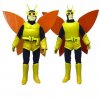An afternoon outing in the park often means a blanket and a picnic basket. It can also mean nature's critters looking to find an easy meal, much like Boris the Raccoon! He's a shady, shifty character, you can see it in his eyes, but really, all he wants is a bite to eat! The first in Nathan Hamill's Picnic Land series of vinyl figures, Boris the Raccoon stands 2 1/2" tall and has two points of articulation. Give him a good home, or he'll steal that sandwich right out of your hands!
|
Bif Bang Pow! blasts off for action with this line of fully articulated, 8" tall action figures based on [adult swim]'s animated series The Venture Bros. You'll find two of the series' most popular characters, Henchman 21 & Henchman 24, faithfully represented in amazing detail, real fabric clothing, and a 1970's retro style that accurately portrays that distinctive action-comedy mix that has become synonymous with the TV series! Clamshell packaging.
|
The Smurfs always have a smurfing good time in Smurf Village, and it's not difficult to see why with the Mega Bloks Smurf Large Playset! The Smurfs are holding a carnival, with rides, windmills, food, drink, even a Ferris Wheel! Children young and old can build this exciting piece of Smurf Village, and with the industry-standard building blocks they can customize the carnival to make it into something truly smurftastic!
|
Smurf Village is always full of excitement, and with the Mega Bloks Smufs Small Playsets you can take your Smurfly adventures indoors! These playsets let fans of the characters recreate the mushroom hovels that Smurfette and Papa Smurf called home. Use these industry-standard building blocks and customize these homes into something smurftacular!
Papa Smurfs House ONLY.
|
Add some vibrancy to Smurf Village as you construct these sets of some of the town's smufly exciting residents! Baker Smurf oversees all the baking needs in Smurf Village, whether it's cakes or cookies or danishes that the town needs. Each set comes with pieces to build a little scene around these Smurfs.
|
Add some vibrancy to Smurf Village as you construct these sets of some of the town's smufly exciting residents! Harmony Smurf is Smurf Village's resident musician, despite his lack of obvious musical talent, though perhaps Smurfette simply cannot appreciate his artistic tendencies. Each set comes with pieces to build a little scene around these Smurfs.
|
A classic character of film, television, radio, and comic books returns to the big screen in Columbia Pictures' feature film The Green Hornet, starring Seth Rogen as the vigilante crime-fighter. These 2" figures feature all the coolness and articulation of the larger counterparts at 1/3 the size. Both The Green Hornet and Kato can fit inside their famous car, The Black Beauty. The Black Beauty is the first car to ever be transformed into a Mez-Itz vehicle. It measures nearly 6" long and features a detailed cockpit. These figures comes packaged together in a window box.
|
Created by Alex Rodrigue, the Pocket Zombies are adorable little Zombies always ready to laugh and of course, to play with your delicious brain! Wondoo is Ted's dog. He loves to play with Ted and his undead sister Apple. He also alerts them when the Scary Men come close. He often stumbles upon his own tongue. Made of PVC, Wondoo stands 3 1/2" tall.
|
A last minute replacement in the Great Race of Oban after the tragic crash of champion Rick Thunderbolt, the rebellious and spunky 15 year-old Molly has a lot resting on her shoulders. She must win the race at all costs to protect the Earth - and show her stern father Don Wei what she's made of. Based on the main character from the internationally acclaimed Oban Star Racers anime. Molly is brought to life as a series of 7 1/4" vinyl figures, and collectors can choose from Original Molly, Xtra Spicy Twilight Molly (limited to 500), Black Bean Edition Molly (limited to 250), Xtra Spicy Glow Molly (limited to 200), and Classico Molly (limited to 250).Each figure comes in a full-color box.
|
GENSHI:TOY presents Kricky The Alien Frog! From Craig Anthony Perkins, the designer who created the Broken Heart Robot, comes the Robot's little sidekick, Kricky The Alien Frog. Hatched on Planet R-bit, Kricky is one of one zillion-gajillion frogs hatched at the Frogatorium Emporium, only this one stowed away on the Broken Heart Robot's spaceship for a lifetime of adventure throughout space! Standing 3 3/4" tall, Kricky has a removable head so you can mix and match with the various colorways. Limited to 350 pieces.
|
Everyone loves ice cream! (Unless you're lactose intolerant, in which case it's probably best to avoid ice cream at all costs. Yes, best that.) But sometimes, very rarely, ice cream turns evil! Dropped on the ground, left to melt, unloved, unwanted. Evil. Ice Clown will melt... your heart, that is! This evil ice cream cone is made of polystone and stands 5" tall.
|
Two killer toys from Bif Bang Pow!
•Won't you give Talky Tina and Willie a try?
•SDCC Exclusive action figures based on the The Twilight Zone TV series!
•Feature retro, vintage-style sculpting with authentic fabric clothing - on a "child sized" body.
Comic-Con San Diego 2010 Exclusive! Faithful followers of the iconic The Twilight Zone TV series have reason to rejoice. Bif Bang Pow! brings an astonishing assortment of fully articulated, 8-inch scale action figures to your table. Each extraordinarily lifelike character features authentic fabric clothing and a retro design that's sure to please fans of the most popular action figures of the 1970s. These black-and-white figures come individually carded in blister packaging.
This Series 3 set includes 2 individually packaged action figures (subject to change):
1x Talky Tina
1x Willie the Dummy
Long before Chucky, there was Talky Tina, star of one of the most spine-chilling episodes of The Twilight Zone ever aired. In the show titled "Living Doll" that also starred Telly Savalas, Tina kept coming back and coming back, no matter what he did to try to destroy her. If you remember that frightening episode, you may think twice before ordering this item. But don't worry. After all, she's only an innocent action figure… or is she? Tina features fabric clothing, multiple points of articulation, and a retro design right out of the 1970s!
Based on the ultra-eerie 1962 The Twilight Zone episode titled "The Dummy" that starred Cliff Robertson, this almost-too-real rendering of Willie may make your skin crawl. But no need to feel threatened. He comes in actual fabric clothing and is designed after very popular action figures of the 1970s. Won't you give Willie a try?
|
If you've been searching for action figures from Lost, search no more. They're right here! Each fan-favorite character stands 8" tall in a retro action figure style. With fabric clothing and multiple points of articulation, these figures are both authentic and lifelike. Clamshell packaging.
|
If you've been searching for action figures from Lost, search no more. They're right here! Each fan-favorite character stands 8" tall in a retro action figure style. With fabric clothing and multiple points of articulation, these figures are both authentic and lifelike. Includes Jacob and the Man in Black! Clamshell packaging.
|
Faithful followers of Rod Serling's The Twilight Zone have reason to rejoice. Bif Bang Pow! brings an astonishing assortment of fully articulated, 8" tall action figures to your table. Each exceptionally lifelike character features authentic fabric clothing and a retro design that's sure to please fans of the most popular action figures of the 1970s. Clamshell packaging.
|
















